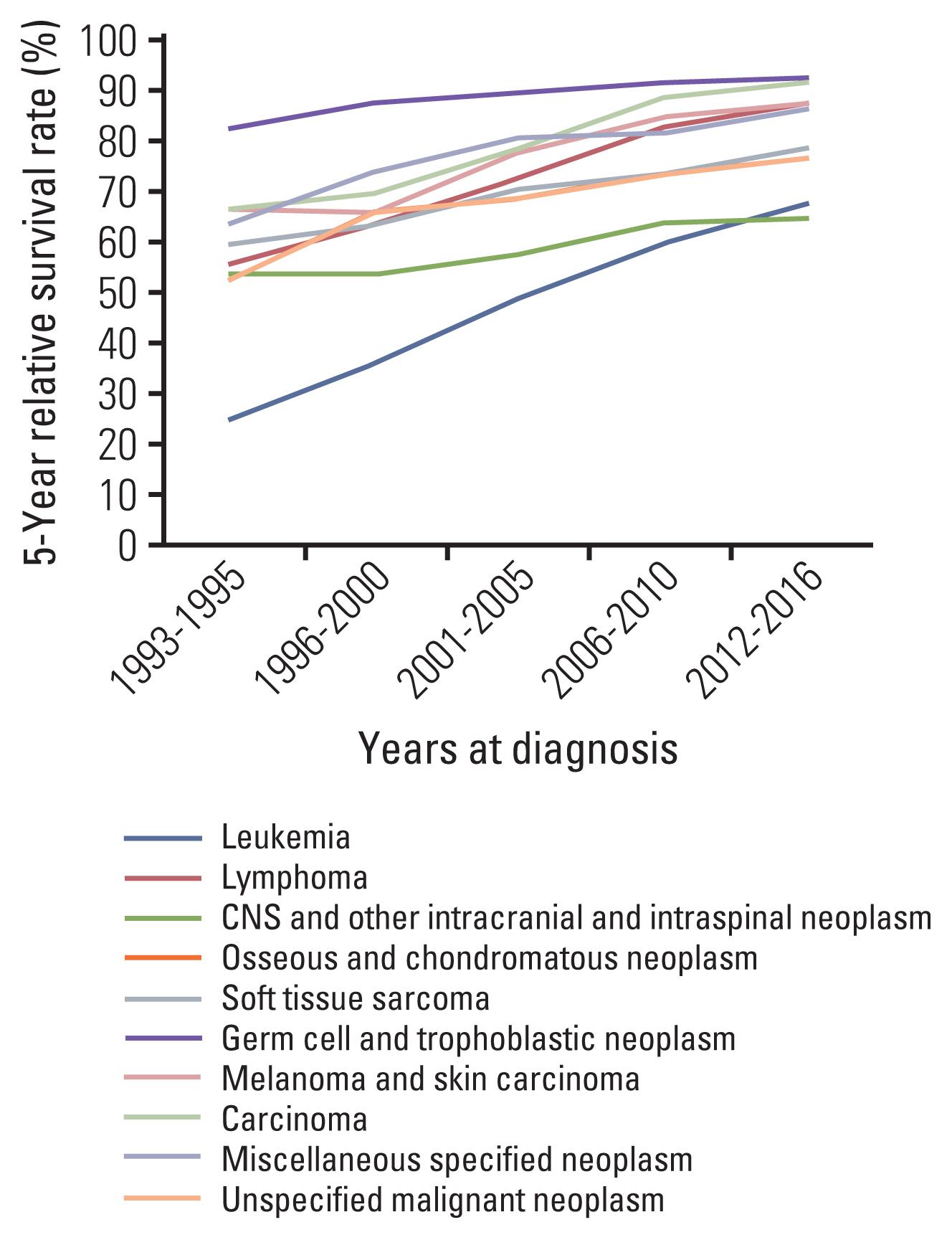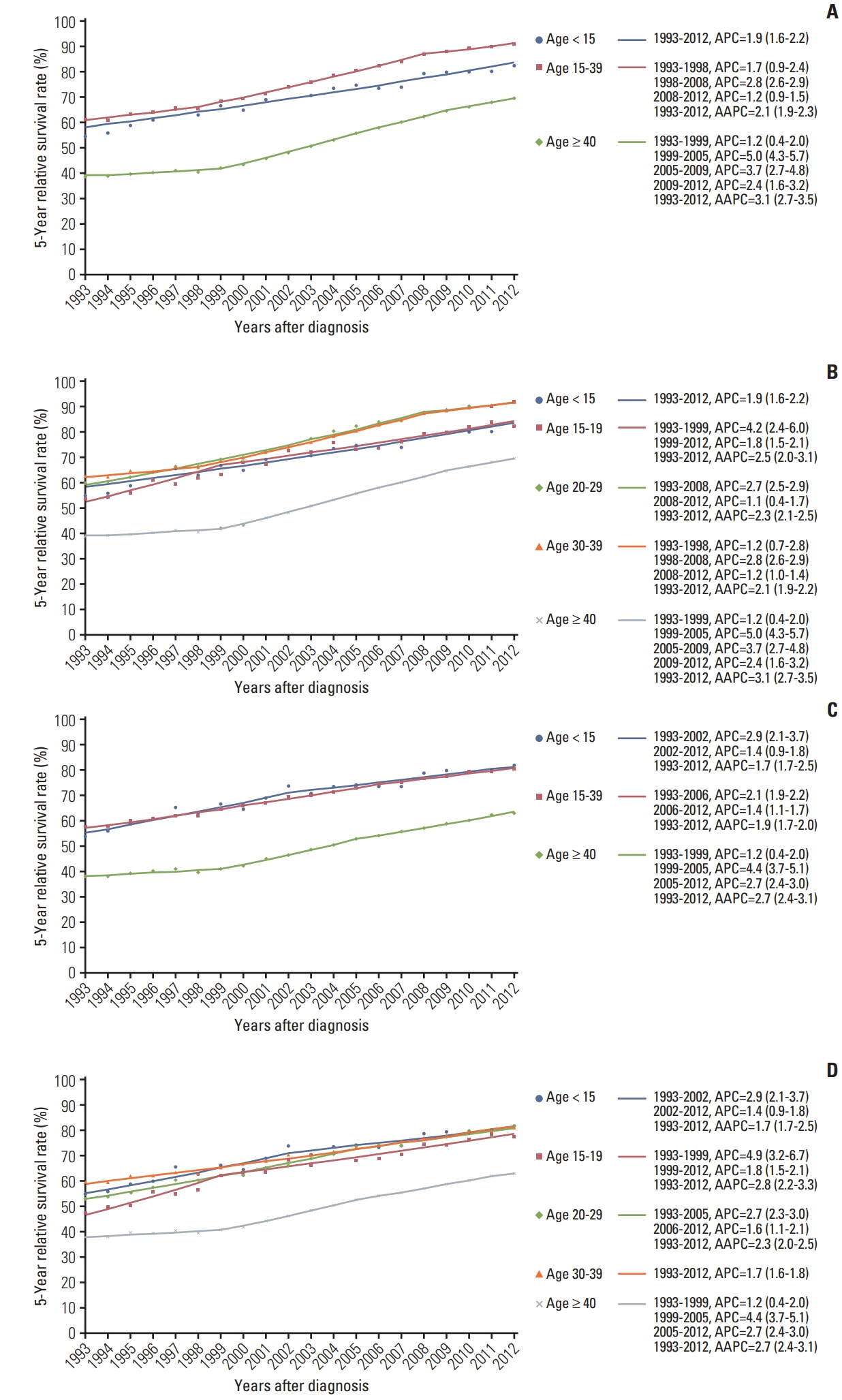Cancer Res Treat.
2021 Jan;53(1):32-44. 10.4143/crt.2020.644.
Cancer Incidence and Survival among Adolescents and Young Adults in Korea: An Update for 2016
- Affiliations
-
- 1Department of Pediatrics, Center for Pediatric Cancer, National Cancer Center, Goyang, Korea
- 2Division of Cancer Registration and Surveillance, National Cancer Center, Goyang, Korea
- KMID: 2510645
- DOI: http://doi.org/10.4143/crt.2020.644
Abstract
- Purpose
This study investigated the incidence and relative survival rates (RSRs) for cancers among adolescents and young adults (AYAs) aged 15-39 years between 1993 and 2016 in Korea
Materials and Methods
Data from the Korea Central Cancer Registry were used to calculate percent distributions, age-specific incidence rates, age-standardized incidence rates (ASRs) per million, annual percent changes (APCs), average APCs, and RSRs for cancers diagnosed in AYAs.
Results
ASR of all cancers among AYAs was 654.5 per million. The largest diagnosed group of cancers was carcinomas (almost 80%). Crude incidence increased with age, from 170.4 per million for those aged 15-19 years to 1,639.8 per million for those aged 35-39 years. ASR increased from 414.8 per million to 820.4 per million, with an APC of 9.0%. The incidence of thyroid carcinoma showed the most rapid increment (APC, 14.0%), followed by non-Hodgkin lymphoma (APC, 13.4%). The 5-year RSR among AYAs significantly improved from 62.1% to 90.8%. Survival improvement in AYAs was higher than that in children but lower than that in older adults (APC, 2.1% vs. 1.9% vs. 3.1%). The most marked survival improvement was found for leukemia and lymphoma. Astrocytoma, rhabdomyosarcoma, and carcinoma of the trachea, bronchus, and lung had a 5-year RSR of < 50%.
Conclusion
There was an improvement in cancer survivals in AYAs, comparable to that achieved in children. However, survivals in several cancer types do not appear to be improving. Further research focusing on the epidemiology and therapeutic strategies for cancers in AYAs is needed.
Keyword
Figure
Reference
-
References
1. Arnett JJ. Emerging adulthood. A theory of development from the late teens through the twenties. Am Psychol. 2000; 55:469–80.
Article2. U.S. Department of Health and Human Services, National Institutes of Health, National Cancer Institute and the LiveStrong Young Adult Alliance. Adolescent and Young Adult Oncology Progress Review Group: closing the gap: research and care imperatives for adolescents and young adults with cancer. NIH Pub No. 06-6067. Bethesda, MD: National Cancer Institute;2006.3. Desandes E, Stark DP. Epidemiology of adolescents and young adults with cancer in Europe. Prog Tumor Res. 2016; 43:1–15.
Article4. Bleyer A. Young adult oncology: the patients and their survival challenges. CA Cancer J Clin. 2007; 57:242–55.
Article5. Burke ME, Albritton K, Marina N. Challenges in the recruitment of adolescents and young adults to cancer clinical trials. Cancer. 2007; 110:2385–93.
Article6. Bleyer A, Choi M, Fuller CD, Thomas CR Jr, Wang SJ. Relative lack of conditional survival improvement in young adults with cancer. Semin Oncol. 2009; 36:460–7.
Article7. Gatta G, Zigon G, Capocaccia R, Coebergh JW, Desandes E, Kaatsch P, et al. Survival of European children and young adults with cancer diagnosed 1995–2002. Eur J Cancer. 2009; 45:992–1005.
Article8. Keegan TH, Ries LA, Barr RD, Geiger AM, Dahlke DV, Pollock BH, et al. Comparison of cancer survival trends in the United States of adolescents and young adults with those in children and older adults. Cancer. 2016; 122:1009–16.
Article9. Bleyer A, Ferrari A, Whelan J, Barr RD. Global assessment of cancer incidence and survival in adolescents and young adults. Pediatr Blood Cancer. 2017; 64:e26497.
Article10. Jung KW, Won YJ, Kong HJ, Oh CM, Seo HG, Lee JS. Cancer statistics in Korea: incidence, mortality, survival and prevalence in 2010. Cancer Res Treat. 2013; 45:1–14.
Article11. Stark D, Bielack S, Brugieres L, Dirksen U, Duarte X, Dunn S, et al. Teenagers and young adults with cancer in Europe: from national programmes to a European integrated coordinated project. Eur J Cancer Care (Engl). 2016; 25:419–27.
Article12. Moon EK, Park HJ, Oh CM, Jung KW, Shin HY, Park BK, et al. Cancer incidence and survival among adolescents and young adults in Korea. PLoS One. 2014; 9:e96088.
Article13. Fritz A, Percy C, Jack A, Shanmugaratnam K, Sobin L, Parkin DM, et al. International Classification of Diseases for Oncology. 3rd ed. Geneva: World Health Organization;2000.14. Bleyer A, O’Leary M, Barr R, Ries LA. Cancer epidemiology in older adolescents and young adults 15 to 29 years of age, including SEER incidece and survival: 1975–2000. NIH Pub No. 06-5767. Bethesda, MD: National Cancer Institute;2006.15. Barr RD, Holowaty EJ, Birch JM. Classification schemes for tumors diagnosed in adolescents and young adults. Cancer. 2006; 106:1425–30.
Article16. Howlader N, Noone AM, Krapcho M, Garshell J, Neyman N, Altekruse SF, et al. SEER Cancer Statistics Review, 1975–2010 [Internet]. Bethesdsda, MD: National Cancer Institute;2013. [cited 2020 Sep 29]. Available from: https://seer.cancer.gov/archive/csr/1975_2010/ .17. Brenner H, Gefeller O. Deriving more up-to-date estimates of long-term patient survival. J Clin Epidemiol. 1997; 50:211–6.
Article18. Kim HJ, Fay MP, Feuer EJ, Midthune DN. Permutation tests for joinpoint regression with applications to cancer rates. Stat Med. 2000; 19:335–51.
Article19. Barr RD, Ferrari A, Ries L, Whelan J, Bleyer WA. Cancer in adolescents and young adults: a narrative review of the current status and a view of the future. JAMA Pediatr. 2016; 170:495–501.20. Trama A, Botta L, Foschi R, Ferrari A, Stiller C, Desandes E, et al. Survival of European adolescents and young adults diagnosed with cancer in 2000–07: population-based data from EUROCARE-5. Lancet Oncol. 2016; 17:896–906.
Article21. Alston RD, Geraci M, Eden TO, Moran A, Rowan S, Birch JM. Changes in cancer incidence in teenagers and young adults (ages 13 to 24 years) in England 1979–2003. Cancer. 2008; 113:2807–15.
Article22. Marrett LD, Frood J, Nishri D, Ugnat AM; Cancer in Young Adults in Canada Working Group. Cancer incidence in young adults in Canada: preliminary results of a cancer surveillance project. Chronic Dis Can. 2002; 23:58–64.23. Hogan AR, Zhuge Y, Perez EA, Koniaris LG, Lew JI, Sola JE. Pediatric thyroid carcinoma: incidence and outcomes in 1753 patients. J Surg Res. 2009; 156:167–72.
Article24. Berkun L, Rabinowicz R, Barchana M, Liphshiz I, Linn S, Futerman B, et al. Cancer incidence and survival among adolescents in Israel during the years 1998 to 2009. Pediatr Blood Cancer. 2013; 60:1848–54.
Article25. Lee JH, Shin SW. Overdiagnosis and screening for thyroid cancer in Korea. Lancet. 2014; 384:1848.
Article26. Cook MB, McGlynn KA, Devesa SS, Freedman ND, Anderson WF. Sex disparities in cancer mortality and survival. Cancer Epidemiol Biomarkers Prev. 2011; 20:1629–37.
Article27. Derwahl M, Nicula D. Estrogen and its role in thyroid cancer. Endocr Relat Cancer. 2014; 21:T273–83.
Article28. Rahbari R, Zhang L, Kebebew E. Thyroid cancer gender disparity. Future Oncol. 2010; 6:1771–9.
Article29. Rebai M, Kallel I, Charfeddine S, Hamza F, Guermazi F, Rebai A. Association of polymorphisms in estrogen and thyroid hormone receptors with thyroid cancer risk. J Recept Signal Transduct Res. 2009; 29:113–8.30. Rajoria S, Suriano R, Shanmugam A, Wilson YL, Schantz SP, Geliebter J, et al. Metastatic phenotype is regulated by estrogen in thyroid cells. Thyroid. 2010; 20:33–41.
Article31. Park HJ, Moon EK, Yoon JY, Oh CM, Jung KW, Park BK, et al. Incidence and survival of childhood cancer in Korea. Cancer Res Treat. 2016; 48:869–82.
Article32. Tichy JR, Lim E, Anders CK. Breast cancer in adolescents and young adults: a review with a focus on biology. J Natl Compr Canc Netw. 2013; 11:1060–9.
Article33. Johnson RH, Anders CK, Litton JK, Ruddy KJ, Bleyer A. Breast cancer in adolescents and young adults. Pediatr Blood Cancer. 2018; 65:e27397.
Article34. Gondos A, Hiripi E, Holleczek B, Luttmann S, Eberle A, Brenner H, et al. Survival among adolescents and young adults with cancer in Germany and the United States: an international comparison. Int J Cancer. 2013; 133:2207–15.
Article35. Bleyer A, Barr R, Hayes-Lattin B, Thomas D, Ellis C, Anderson B, et al. The distinctive biology of cancer in adolescents and young adults. Nat Rev Cancer. 2008; 8:288–98.
Article36. Ferreira CG, de Melo AC, Nogueira-Rodrigues A. The adolescent and young adult with cancer: state of the art: epithelial cancer. Curr Oncol Rep. 2013; 15:287–95.
- Full Text Links
- Actions
-
Cited
- CITED
-
- Close
- Share
- Similar articles
-
- Adolescents and young adults (AYA) with acute lymphoblastic leukemia
- Optimal therapy for adolescents and young adults with acute lymphoblastic leukemia-current perspectives
- Management of Type 2 Diabetes Mellitus in Adolescents and Young Adults
- Cancer Statistics in Korea: Incidence, Mortality, Survival, and Prevalence in 2016
- Strategies for colorectal cancer screening and post-polypectomy surveillance for young adults under age 50






